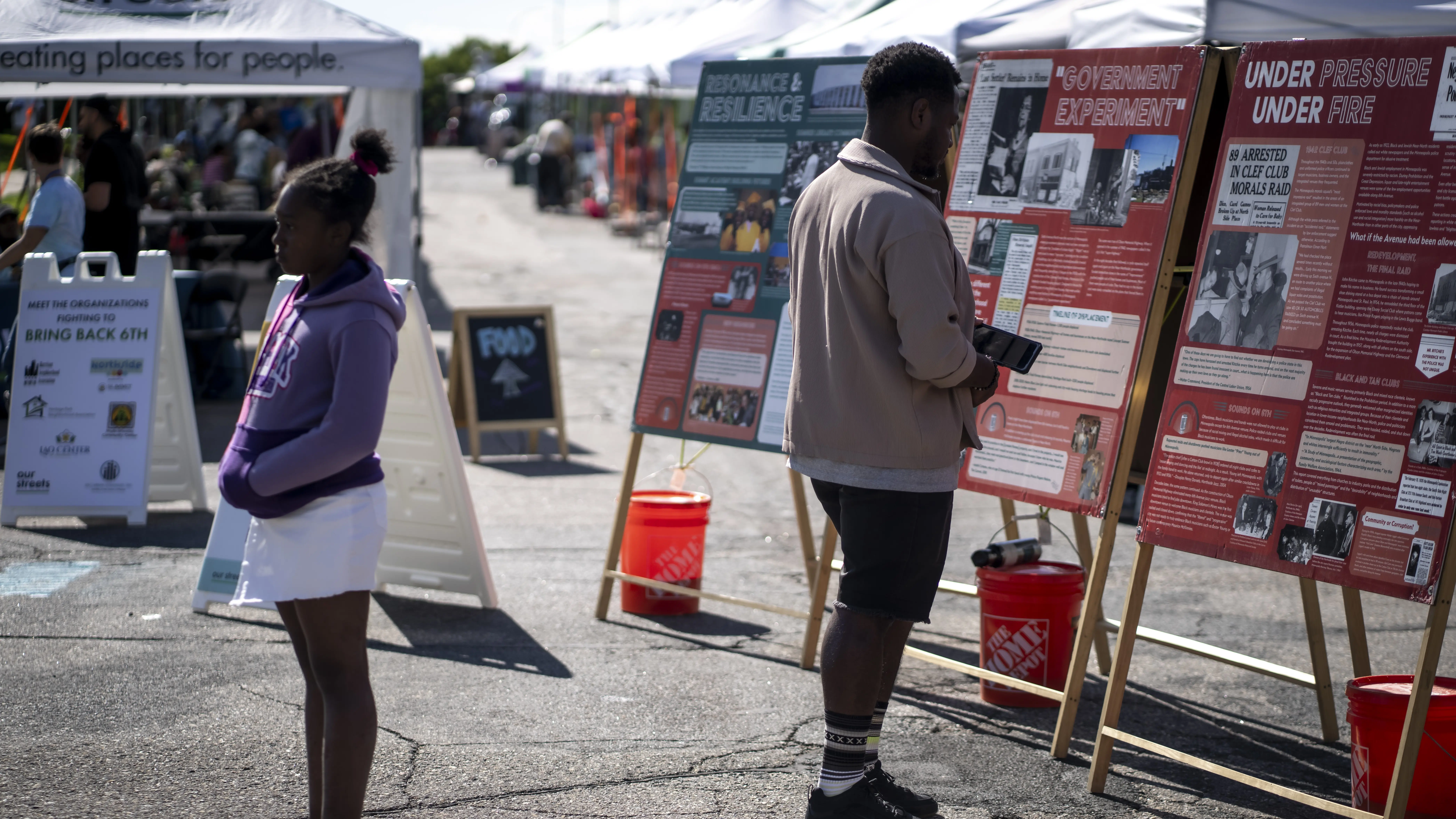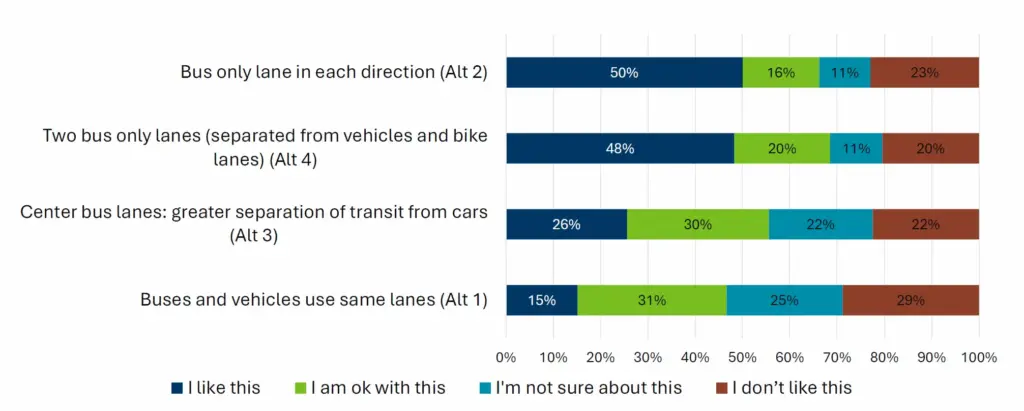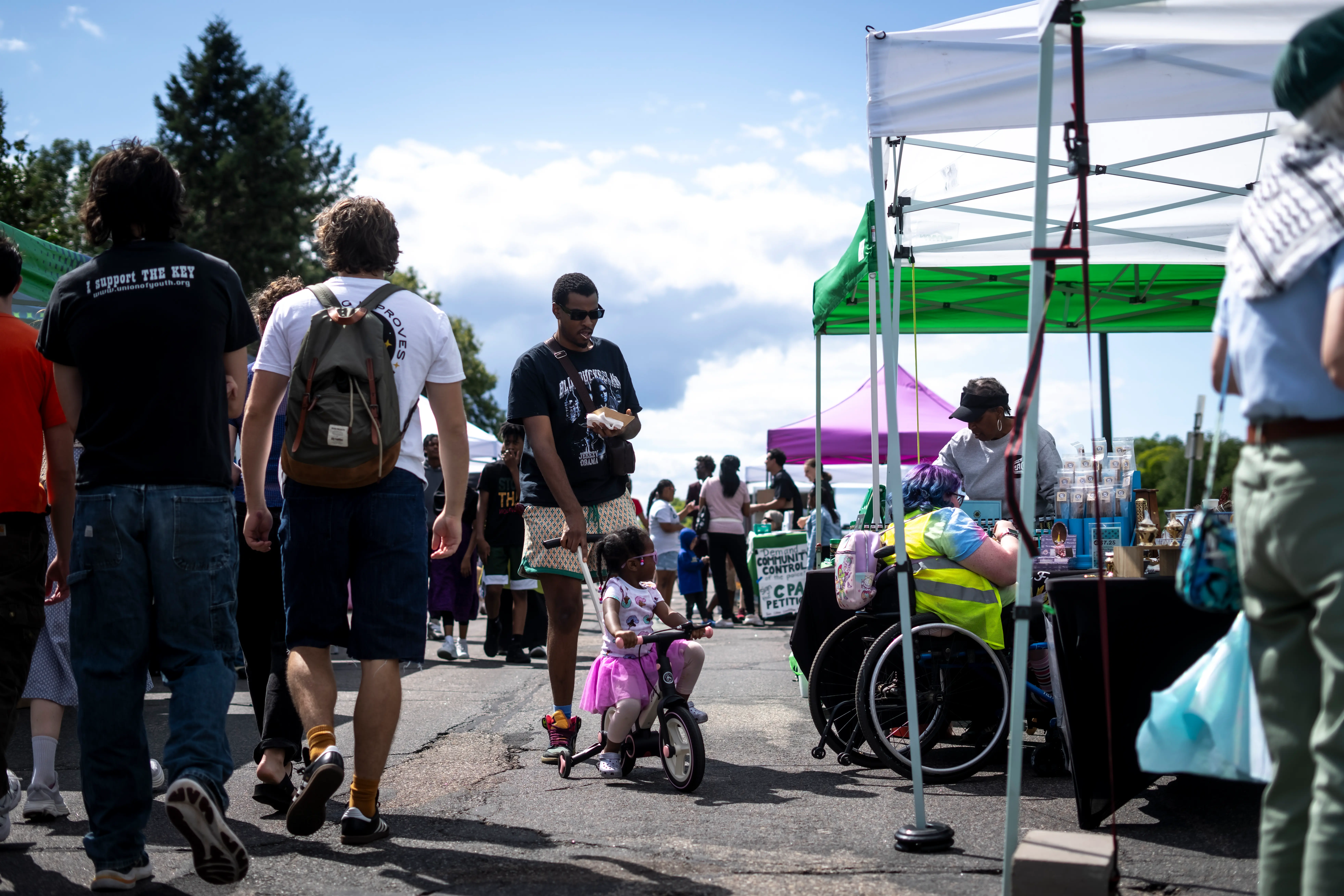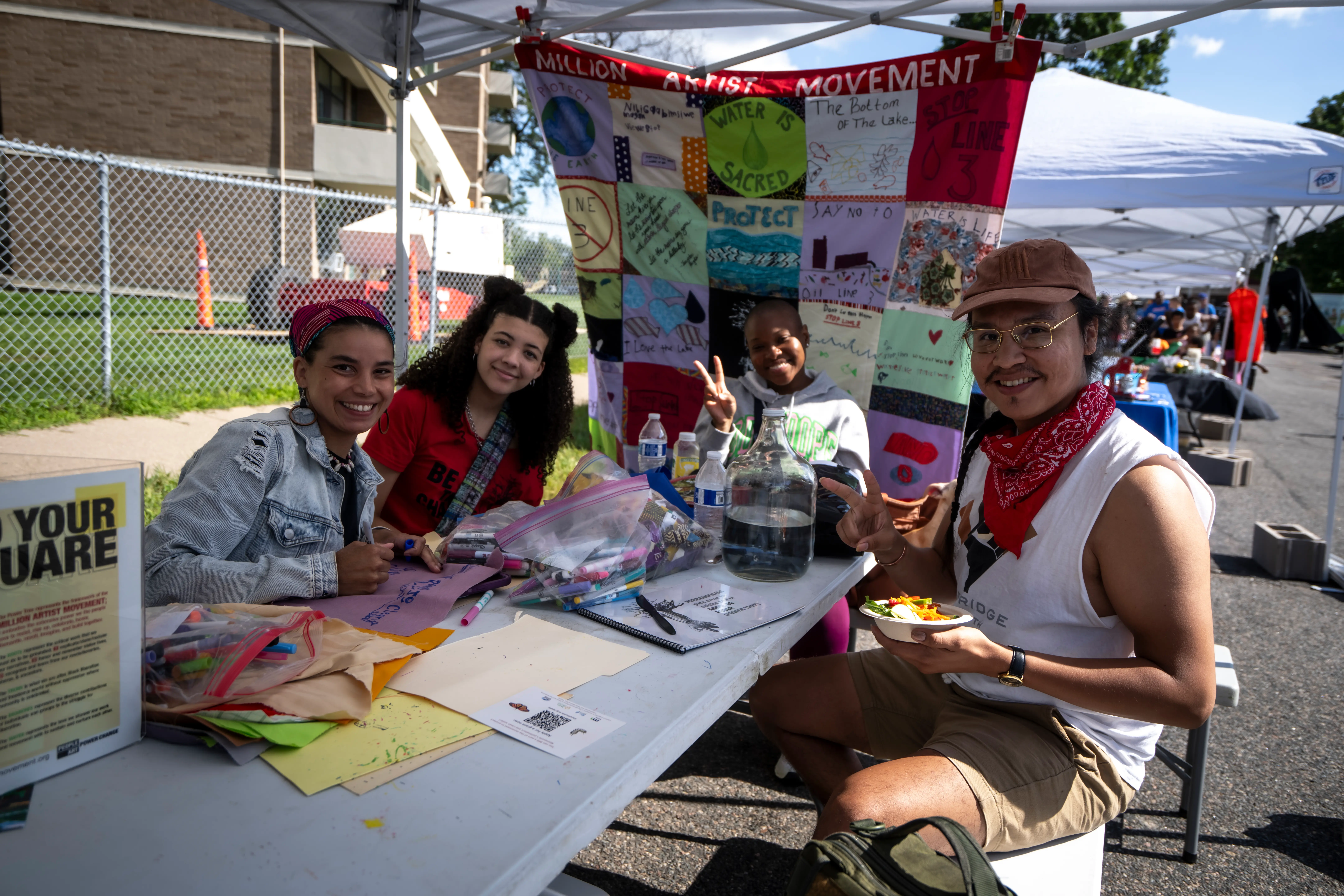
MnDOT said a “walkable main street” scored highest with community members, which was mirrored in community engagement activities on Saturday.
On Thursday, August 8, the Minnesota Department of Transportation (MnDOT) held a virtual meeting of the Policy Advisory Committee (PAC) for their Olson Memorial Highway project. The PAC is made up of elected and appointed officials who represent the neighborhoods surrounding Olson Memorial Highway in North Minneapolis. MnDOT convenes public PAC meetings every few months to share updates about the project and get feedback about the future of Olson Memorial Highway.
| Representative | Governing Body | Office Present or Absent? |
| Representative Esther Agbaje | Minnesota House | Absent |
| Senate President Bobby Joe Champion | Minnesota Senate | Present |
| County Board Chair Irene Fernando | Hennepin County Commissioner | Present |
| Council Member Jeremiah Ellison | Minneapolis City Council | Present |
| Park Board Member Becka Thompson | Minneapolis Park Board | Present |
| Council Member Yassin Osman | Metropolitan Council | Present |
| Khani Sahebjam (PAC Chair) | MnDOT | Present |
During this most recent PAC meeting, MnDOT shared the results of their public engagement about the four initial design ideas for the future of Olson Memorial Highway.
MnDOT’s community engagement results show that community members want a walkable main street through the Near North.
MnDOT shared the result of their public engagement survey, which asked for feedback on four different design concepts for the future of Olson Memorial Highway. The designs that had the narrowest roadways, dedicated bus lanes and returned the most land to the community (Alternative 2 and Alternative 4) were most favored.
Engagement Themes: Transit

The lowest-scoring option did not include dedicated bus lanes and maintained four lanes for cars (Alternative 1). The results of MnDOT’s survey reflect our conversations with community. Residents, organizations and businesses along Olson Memorial Highway want a restored 6th Avenue North, not a modified highway.
Engagement Themes: Driving

The meeting was well attended by PAC members and their staff. Many PAC members asked questions about the project process and shared suggestions on how to improve it.
Bethany Turnwall, from Ward 5 Minneapolis Council Member Jeremiah Ellison’s office, shared the City’s support for Alternative 2 and pressed MnDOT about why there are no plans to install additional safety improvements before the project begins construction. Park Board Commissioner Becka Thompson encouraged MnDOT to extend the project area to connect with Theodore Wirth Parkway in Golden Valley, improving access to the park system across a border that was historically used to enforce segregation. Hennepin County Board Chair Irene Fernando shared support for dedicated bus lanes and encouraged MnDOT to ensure that the project aligns with a long-planned and recently funded bus rapid transit on the Highway 55 project between Minneapolis and Medina.
Thanks to community support, Alternative 2 is moving forward, but major questions and concerns remain.
Out of the four initial designs shared earlier this year, MnDOT announced they are moving forward with three of them. Alternative 2, which is the preferred design of the Bring Back 6th chapter of the MN Communities Over Highways Coalition and includes dedicated bus lanes and one general traffic lane in each direction, will continue to advance in MnDOT’s process.
However, MnDOT also continues to move forward with overbuilt options that would perpetuate safety issues and reduce the amount of land that could be returned to the community. Alternative 1, which features no dedicated bus lanes and 4 traffic lanes, is still an option, despite a poor score in the community survey. When PAC Members asked MnDOT staff about this, it was implied that this option was set to be discarded, but it was kept at the suggestion of the Federal Highway Administration.
Many PAC members shared positive comments and expressed support for restoring 6th Avenue North.
Safety improvements and policies to prevent displacement were not mentioned in MnDOT’s presentation. When PAC members shared concerns that, despite the recent lane reduction, Olson Memorial Highway was still unsafe and that additional changes were needed to prevent severe crashes before the major project starts in a couple of years, MnDOT staff were not-committal. MnDOT’s Metro District Engineer Khani Sahebjam openly questioned whether it would be worth it to make additional safety improvements when the roadway was set to be torn up and rebuilt in a couple of years. Given the long history of disinvestment and safety issues on Olson Memorial Highway, it is unacceptable for MnDOT to characterize changes that could save lives as being too expensive. MnDOT spends hundreds of millions on highway expansion projects every year, which are proven to only make traffic worse. Quick fixes on Olson, like adding flashing beacons to mid-block crosswalks and restriping the roadway to support a safer speed limit, would cost a tiny fraction of MnDOT’s budget and could be completed in a matter of weeks.
Furthermore, when MnDOT staff were asked about repurposing excess highway land and enacting policies to prevent displacement and gentrification, MnDOT had little to say. MnDOT staff said that they are in conversations with staff from the City of Minneapolis Community Planning & Economic Development Department (CPED) about how land could be repurposed and what utilities may need to be relocated to accommodate new buildings. No information about this analysis has been shared with the public, and MnDOT staff made no mention of working with project partners to implement policies to prevent gentrification and allow Northside residents to create a vision for repurposed highway land.
This raises broader questions about whether MnDOT is adequately engaging with the community and comprehensively planning for the corridor’s future. Projects like the 11th Street Bridge project in DC have shown how anti-displacement and community benefit programs must begin years before construction starts. Now is the time to work with community members to design and fund anti-displacement protections and reparations to be paired with the reimagined street.
Despite the meeting being open to the public, community members were excluded.
MnDOT staff intentionally shut community members out of the meeting. The Zoom meeting chat was disabled and there was no Q&A feature. Past PAC meetings have included a 15-minute public comment period at the end of the meeting. It was like watching the meeting through a one-way mirror, with no way to ask questions or respond to MnDOT’s claims about community engagement.
Imagine 6th Avenue: More than Just a Block Party
In contrast, two days later on Saturday, August 10th, the community gathered to openly discuss and co-create a vision for the future of Olson Memorial Highway. At the event, families learned about street design in Harrison Park in the Near North neighborhood of Minneapolis as children tie-dyed tote bags and jumped in a bouncy house. The neo-soul vocals of Traiveon serenaded the community gathering while The Dream Shop vendors sold local wares. People enjoyed Jamaican jerk chicken from one of the many food trucks that collaborated with Our Streets to offer free food during Imagine 6th Avenue North.

More than just a fun block party, the Imagine 6th Avenue event was also a successful community outreach opportunity to uplift the Bring Back 6th campaign. One of the goals of the Imagine series is to empower communities to engage with transportation projects in their neighborhood. In this instance, we provided neighbors in Near North Minneapolis with information about the Minnesota Department of Transportation’s (MnDOT) Olson Memorial Highway reconstruction project so they could provide input in the process. We worked with Toole Design Group and the University of Minnesota Design Center to create activities to capture community experiences and priorities for the future of Olson Memorial Highway.

In order for residents from both sides of the highway to safely attend the event, Our Streets had to provide crossing guards and a shuttle across the highway. As is, the highway is too dangerous to comfortably cross. Since its construction, Olson Memorial Highway has been hazardous for the people who live nearby. Near North community members have sought improvements for decades to make Olson Memorial Highway safer. Despite hundreds of severe crashes and dozens of fatalities, the corridor has been largely ignored by MnDOT and the City of Minneapolis.
During the PAC meeting, we learned more about the project’s upcoming timeline. MnDOT staff said that they will reconvene an advisory committee for the project this fall. MnDOT will continue to refine a potential design and seek input from the community over the next 18 months, with construction on the reimagined street wrapping up in 2028. The Bring Back 6th chapter of the MN Communities Over Highways Coalition will continue to monitor this process and share updates about future meetings and opportunities to engage in building a better future for the corridor.
Get Involved
Attend a MnDOT project pop-up event.
August 14 | 6-7 PM | Theater in the Park at Harrison Park
August 26 | 7 PM | Music in the Park at North Commons Park
Take Action.
Send an email to project decision-makers! You can also contact the project team directly at olsonmemorialhighway.dot@state.mn.us.